Shutdown of San Onofre Will Increase Pressure and Prices

 Credit: Julius Fekete / Shutterstock.com
Credit: Julius Fekete / Shutterstock.com
Although the debate on the pros and cons of nuclear energy has strong arguments for both sides of the spectrum, the permanent shutdown of the San Onofre Nuclear Generation Station (SONGS) will undoubtedly place greater pressure on California to begin planning for a reliable long-term energy agenda.
Southern California Edison, owner of SONGS, decided to make the move to close the plant last week. Since early January 2012, SONGS shutdown after Unit 3 began leaking small amounts of radioactive material. Upon investigation, it was soon discovered that more than 3,000 tubes within the generators had excessive signs of premature wear. All were in danger of leaking radioactive material.
Before the January shutdown, San Onofre readily produced 2,710 Megawatts of electricity, enough to satisfy power demand in Orange County, Riverside, and San Diego Counties. San Onofre and Diabo Canyon nuclear plants together generated nearly 16 percent of the state's electricity. Diablo Canyon, located in San Luis Obispo, is now the only remaining nuclear power plant functioning in California.
Californians are already paying some of the highest electric bill rates in the nation. Because of the state's tiered rate structure, many Californians may feel an even greater pinch with dramatically higher rates.
The California Independent System Operator (CAISO) has stated that they expect to proceed throughout the summer without any blackouts. However, the state has had its share of rolling blackouts in the past when unusually high temperatures begin to rise. Dry heat and wind cause brushfires leaving acres of destruction and millions of air conditioners are used at once to combat the excessive Southern California heat.
Potential rolling blackouts are a short-term problem with the shutdown of the troubled San Diego power plant. The greater problem may be the difficult task in developing an energy plan that satisfies California's stringent emission standards.
California has one of the most ambitious renewable energy programs in the nation and has appreciably relied on nuclear energy to combat reduction in emissions while continually supplying California's annual increase in demand for electricity.
Prior to the nuclear plant shut down, California hoped to target increased renewable energy production by 33 percent by 2020 with the help of nuclear energy and other renewable energy resources. The Clean and Safe Energy Coalition has stated that in 2o10 alone, Diablo Canyon and San Onofre helped reduce 13 million metric tons of CO2.
San Onofre's shutdown will unquestionably impact California's long-term energy plans. Only time will tell whether energy utilities and the state will provide the reform and energy plan that meet our demanding energy requirements while meeting our environmental mandates for lower emissions and alternative energy resources.
It will be tough for the state to meet strict climate regulations and simultaneously find affordable energy. It is a balancing act that will require careful planning not only from our local government and agencies, but from our neighbors and communities. Setting our differences about nuclear energy aside, there must nonetheless be a push for greater energy conservation and awareness in order to tackle our new looming energy problems in the horizon.



